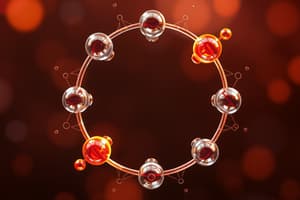Podcast
Questions and Answers
Which group in the periodic table has elements with high (endothermic) first ionization energies and very negative (exothermic) first electron affinities, resulting in the formation of 1- anions?
Which group in the periodic table has elements with high (endothermic) first ionization energies and very negative (exothermic) first electron affinities, resulting in the formation of 1- anions?
- Group 17 (halogens) (correct)
- Group 2 (alkaline earth metals)
- Group 1 (alkali metals)
- Group 16 (chalcogens)
What accounts for the difference in electron affinity between silicon (–134 kJ/mol) and phosphorus (–72 kJ/mol)?
What accounts for the difference in electron affinity between silicon (–134 kJ/mol) and phosphorus (–72 kJ/mol)?
- Silicon has a half-filled 3p subshell, making it less attractive to an extra electron. (correct)
- Silicon has a filled 3p subshell, while phosphorus has a half-filled 3p subshell.
- Phosphorus has a higher effective nuclear charge than silicon.
- Silicon has a larger atomic radius than phosphorus.
How do electron affinities generally change across a period in the periodic table?
How do electron affinities generally change across a period in the periodic table?
- They become less negative. (correct)
- They fluctuate randomly.
- They remain the same.
- They become more negative.
What is the trend in electron affinities as one moves down a group in the periodic table?
What is the trend in electron affinities as one moves down a group in the periodic table?
What effect does a filled 3p subshell have on the electron affinity of phosphorus compared to silicon?
What effect does a filled 3p subshell have on the electron affinity of phosphorus compared to silicon?
Flashcards
Halogens IE1
Halogens IE1
Halogens (Group 17) have high, endothermic first ionization energies.
Halogens EA1
Halogens EA1
Halogens (Group 17) have very negative, exothermic first electron affinities.
Silicon EA
Silicon EA
Silicon's electron affinity is –134 kJ/mol.
Phosphorus EA
Phosphorus EA
Signup and view all the flashcards
EA trend across a period
EA trend across a period
Signup and view all the flashcards
Study Notes
Group with High IE1 and Negative EA1
- Group 17 (the halogens) exhibits high (endothermic) first ionization energies (IE1) and very negative (exothermic) first electron affinities (EA1).
- These atoms form 1- anions.
Silicon vs. Phosphorus Electron Affinity
- Silicon has an electron affinity of –134 kJ/mol.
- Phosphorus has an electron affinity of –72 kJ/mol.
- The difference arises from the electronic configuration of the atoms. Silicon has a half-filled 3p subshell, making it less attractive to an extra electron, while phosphorus has a filled 3p subshell.
Electron Affinity Trends
- Electron affinities generally become less negative across a period (left to right) due to increasing effective nuclear charge and decreasing atomic radii.
- Electron affinities become more negative down a group (top to bottom) due to increasing atomic radii.
Studying That Suits You
Use AI to generate personalized quizzes and flashcards to suit your learning preferences.
Description
This quiz covers the trends of electron affinities, specifically focusing on halogens and comparing silicon and phosphorus. Understand the factors affecting electron affinity as well as the differences in ionization energies among these elements. Test your knowledge of these important concepts in chemistry.




